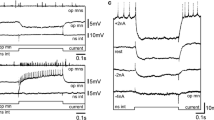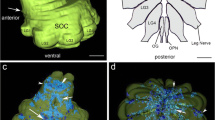Summary
-
1.
Certain gymnotid fish (apteronotids) continuously emit a high-frequency electric-organ discharge and thus continuously drive their electroreceptor afferents at high rates. Electroreceptor afferents terminate in one lamina of the electrosensory lateral line lobe (ELL) and can be readily sampled. Normally these terminals have many small vesicles clustered adjacent to the presynaptic membrane.
-
2.
When afferent activity is blocked for 24 hr by an injection of tetrodotoxin (TTX) into the electroreceptor nerve, the density of vesicles adjacent to the synaptic membrane declines; the volume of the remaining vesicles increases. If the nerve of a TTX-treated fish is stimulated proximal to the injection site, these changes can be reversed.
-
3.
These results imply that the migration of vesicles toward the presynaptic membrane is influenced by the level of activity in the nerve.
Similar content being viewed by others
References
Akert, K., Cuenod, M., and Moor, H. (1971). Further observations on the enlargement of synaptic vesicles in degenerating optice nerve terminals of the avian tectum.Brain Res. 25255–263.
Atwood, H. L., Lang, F., and Morin, W. A. (1972). Synaptic vesicles: Selective depletion in crayfish excitatory and inhibitory axons.Science 1761353–1355.
Bastian, J. (1981). Electrolocation. I. How the electroreceptors ofApteronotus albifrons code for moving objects and other electrical stimuli.J. Comp. Physiol. 144465–479.
Bennett, M. V. L. (1967). Mechanisms of electroreception. InLateral Line Detectors (Cahn, P. H., Ed.), Indiana University Press, Bloomington, pp. 313–393.
Brown, M. C., and Ironton, R. (1977). Motor neurone sprouting induced by prolonged tetrodotoxin block of nerve action potentials.Nature 265459–461.
Carr, C. E., Maler, L., and Sas, E. (1982). Peripheral organization and central projections of the electrosensory nerves in gymnotiform fish.J. Comp. Neurol. 211139–153.
Ceccarelli, B., and Hurlbut, W. P. (1980a). Vesicle hypothesis of the release of quanta of acetylcholine.Physiol. Rev. 60396–441.
Ceccarelli, B., and Hurlbut, W. P. (1980b). Ca2+-dependent recycling of synaptic vesicles at the frog neuromuscular junction.J. Cell Biol. 87297–303.
Csillik, B., and Bense, S. (1971). Function-dependent alterations in the distribution of synaptic vesicles.Acta Biol. Acad. Sci. Hung. 22131–139.
Cuénod, M., Sandri, C., and Akert, K. (1970). Enlarged synaptic vesicles as an early sign of secondary degeneration in the optic nerve terminals of the pigeon.J. Cell Sci. 6605–613.
Dickinson-Nelson, A., and Reese, T. S. (1983). Structural changes during transmitter release at synapses in the frog sympathetic ganglion.J. Neurosci. 342–52.
Fisher, J., and Langmeier, M. (1980). Changes in the number, size, and shape of synaptic vesicles in an experimental, projected cortical epileptic focus in the rat.Epilepsia 21571–585.
Fried, R. C., and Blaustein, M. P. (1978). Retrieval and recycling of synaptic vesicle membrane in pinched-off nerve terminals (synaptosomes).J. Cell Biol. 78685–700.
Gainer, H. (1981). The biology of neurosecretory neurons.Adv. Biochem. Psychopharmacol. 285–20.
Heuser, J. E., and Reese, T. S. (1973). Evidence for recycling of synaptic vesicle membrane during transmitter release at the frog neuromuscular junction.J. Cell Biol. 57315–344.
Heuser, J. E., and Reese, T. S. (1977). Structure of the synapse. InHandbook of Physiology, The Nervous System.Vol. I (Kandel, E. R., Ed.), Part, I, American Physiological Society, Bethesda, Maryland, pp. 262–294.
Israël, M., Dunant, Y., and Manaranche, R. (1979). The present status of the vesicular hypothesis.Prog. Neurobiol. 13237–275.
Jones, S. F., and Kwanbunbumpen, S. (1970). The effects of nerve stimulation and hemicholinium on synaptic vesicles at the mammalian neuromuscular junction.J. Physiol. (Lond.)20731–50.
Kawana, E., Akert, K., and Bruppacher, H. (1971). Enlargement of synaptic vesicles as an early sign of terminal degeneration in the rat caudate nucleus.J. Comp. Neurol. 142297–308.
Kershaw, P., and Christensen, B. N. (1980). A quantitative analysis of ultrastructural changes induced by electrical stimulation of identified spinal cord axons in the larval spinal cord.J. Neurocytol. 9119–138.
Korneliussen, H. (1972). Ultrastructure of normal and stimulated motor endplates.Z. Zellforsch 13028–57.
Langmeier, M., Fischer, J., and Mares, J. (1980a). Changes in some parameters of the presynaptic bag in synapses of the somato-sensory cortex of the rat brain after repetitive electrical stimulation prolonging self-sustained after-discharges. An electron microscopic morphometric study.Physiol. Bohemoslov. 29 553–559.
Langmeier, M., Fischer, J., and Mares, J. (1980b). Number of synaptic vesicles in the rat somatosensory cortex after repetitive electrical stimulation prolonging self-sustained after-discharges.Epilepsia 21255–260.
Langmeier, M., Mares, J., and Fischer, J. (1983). Number of synaptic vesicles in rat cortex immediately after cessation of the self-sustained after-discharge during kindling.Epilepsia 24616–626.
Lnenicka, G. A., and Atwood, H. L. (1985). Age-dependent long term adaptation of crayfish phasic motor axon synapses to altered activity.J. Neurosci. 5459–467.
Lynch, K. (1982). The effects of chronic stimulation on the morphology of the frog neuromuscular junction.Neurocytol. 1181–107.
Maler, L. (1979). The posterior lateral line lobe of certain gymnotid fish: Quantitative light microscopy.J. Comp. Neurol. 183323–363.
Maler, L. (1981). Effects of neuronal activity on the disposition of synaptic vesicles.Soc. Neurosci. Abstr. 7708.
Maler, L., Finger, T., and Karten, H. J. (1974). Differential projections of ordinary lateral line receptors and electro-receptors in the gymnotid fishApteronotus albifrons.J. Comp. Neurol. 158363–382.
Maler, L., Sas, E., and Rogers, J. (1981). The cytology of the posterior lateral line lobe of high frequency weakly electric fish (gymnotidae): Dendritic differentiation and synaptic specificity in a simple cortex.J. Comp. Neurol. 19587–141.
Maloshevskii, S. G., Lenkov, D. N., and Bragina, T. A. (1975). Changes in synaptic vesicles of axon terminals of the cat motor cortex after stimulation.Neurophysiology (USSR) 7495–502.
Mathieson, W. B., and Maler, L. (1983). Spontaneous brusting pacemaker activity in anin vitro preparation of the electrosensory lateral line lobe (ELLL).Soc. Neurosci. Abstr. 9507.
Matthews, M. R., and Raisman, G. (1972). A light and electron microscopic study of the cellular response to axonal injury in the superior cervical ganglion of the rat.Proc. R. Soc. Lond. B 18147–49.
McKinley, R. G., and Usherwood, P. N. R. (1973). The role of the synaptic vesicles in transmission at the insect nerve-muscle junction.Life Sci. 131051–1056.
Model, P. G., Highstein, S. M., and Bennett, M. V. L. (1975). Depletion of vesicles and fatigue of transmission at a vertebrate central synapse.Brain Res. 98209–228.
Morris, J. F., Nordman, J. J., and Dyball, R. E. J. (1978). Structure-function correlation in mammalian neurosecretion.Int. Rev. Exp. Pathol. 181–95.
Pappas, G. D., and Waxman, S. G. (1972). Synaptic fine structure-morphological correlates of chemical and electrotonic transmission. InStructure and Function of Synapses (Pappas, G. D., and Purpura, D. P., Eds.), Raven Press, New York, pp. 1–43.
Perri, V., Sacchi, O., Ravida, E., and Raviola, G. (1972). Evaluation of the number and distribution of synaptic vesicles at cholinergic nerve-endings after sustained stimulation.Brain Res. 39526–529.
Peters, A., Palay, S. L., and Webster, H. de F. (1976).The Fine Structure of the Nervous System, W. B. Saunders, Philadelphia.
Phillipe, E., and Tremblay, J. P. (1983). Increased number per area of peptidergic and cholinergic vesicles in synapses of the chick ciliary ganglion following 10 Hzin vivo stimulation.Neurosci. Lett. 35149–154.
Pysh, J. J., and Wiley, R. G. (1974). Synaptic vesicle depletion and recovery in cat sympathetic ganglia electrically stimulatedin vivo.J. Cell Biol. 60365–374.
Phillips, T. E., and Boyne, A. F. (1984). Liquid nitrogen-based quick freezing: Experience with bounce-free delivery of cholinergic nerve terminals to a metal surface.J. Elect. Micr. Tech. 19–29.
Quillam, J. P., and Tamarind, D. L. (1973). Some effects of preganglionic nerve stimulation on synaptic vesicle populations in the rat superior cervical ganglion.J. Physiol. (Lond.)235317–331.
Robbins, N., and Fischbach, G. D. (1971). Effect of chronic disuse of rat soleus neuromuscular junctions on presynaptic function.J. Neurophysiol. 34570–578.
Szabo, T. (1974). Anatomy of the specialized lateral line organs of electroreception. InHandbook of Sensory Physiology, Vol. III, 13 Electroreceptors and Other Specialized Receptors in Lower Vertebrates (Fessard, A., Ed.), Springer-Verlag, Berlin/New York, pp. 13–58.
Tauc, L. (1982). Nonvesicular release of neurotransmitter.Physiol. Rev. 62857–893.
Tremblay, J. P., and Phillipe, E. (1981). Morphological changes in presynaptic terminals of the chick ciliary ganglion after stimulationin vivo.Exp. Brain Res. 43439–446.
Zimmerman, H. (1982). Insights into the functional role of cholinergic vesicles. InNeurotransmitter Vesicles (Klein, R. L., Lagercrantz, H., and Zimmerman, H., Eds.), Academic Press, New York, pp. 305–359.
Zimmerman, H., and Denston, C. R. (1972b). Separation of synaptic vesicles of different functional states from the cholinergic synapses of theTorpedo electric organ.Neuroscience 2715–730.
Zimmerman, H., and Denston, C. R. (1977a). Recycling of synaptic vesicles in the cholinergic synapses of theTorpedo electric organ during induced transmitter release.Neuroscience 2695–714.
Author information
Authors and Affiliations
Rights and permissions
About this article
Cite this article
Maler, L., Mathieson, W.B. The effect of nerve activity on the distribution of synaptic vesicles. Cell Mol Neurobiol 5, 373–387 (1985). https://doi.org/10.1007/BF00755402
Received:
Revised:
Accepted:
Issue Date:
DOI: https://doi.org/10.1007/BF00755402




